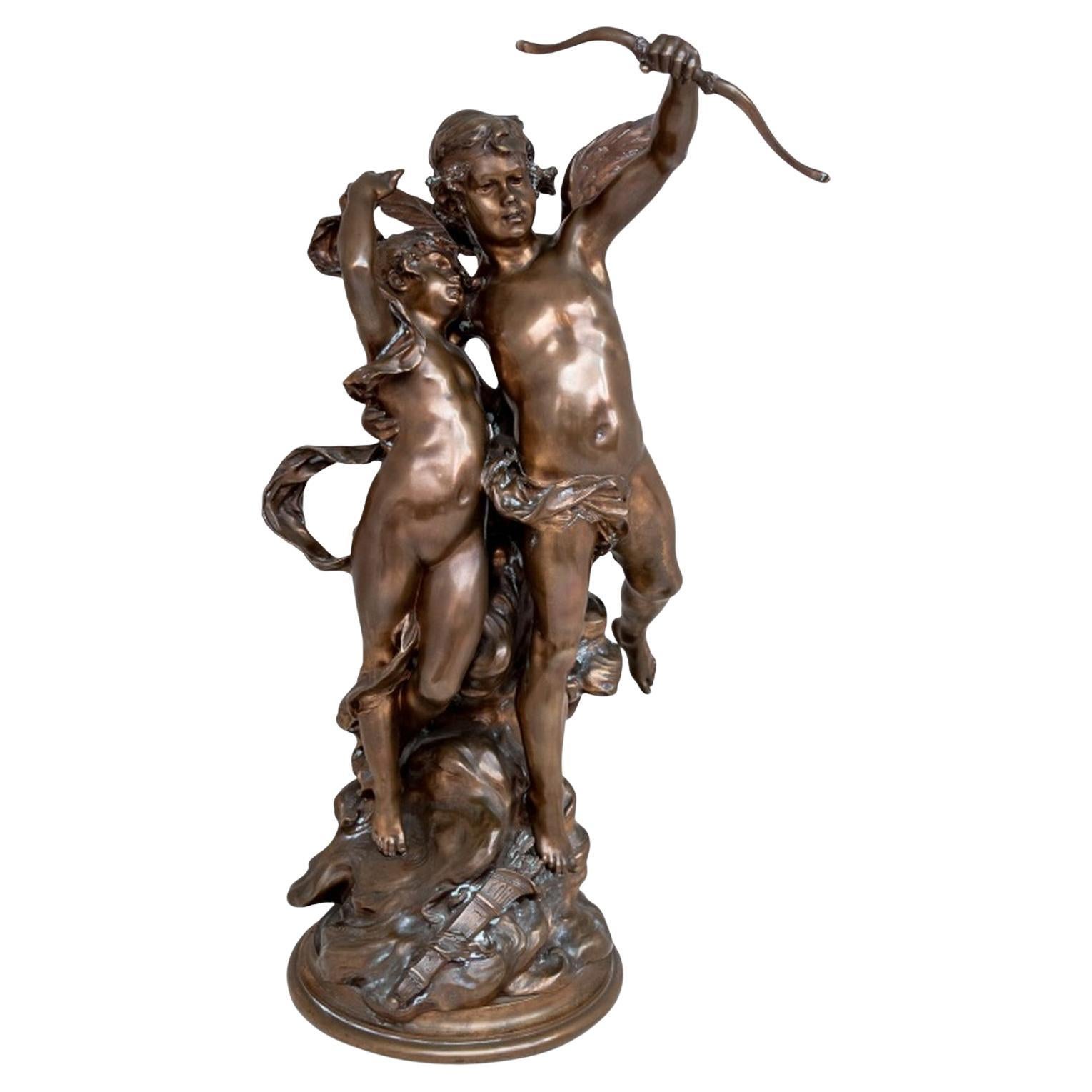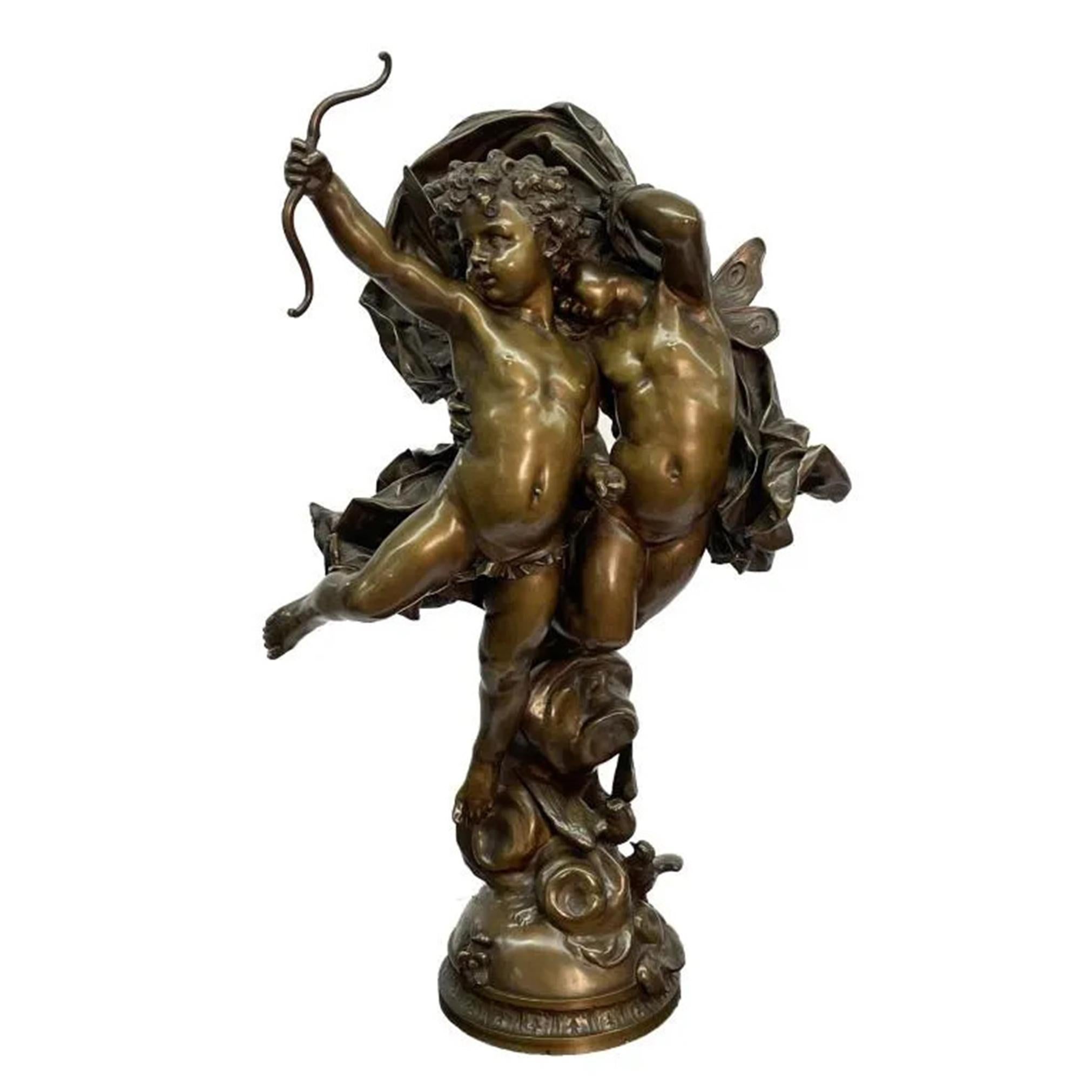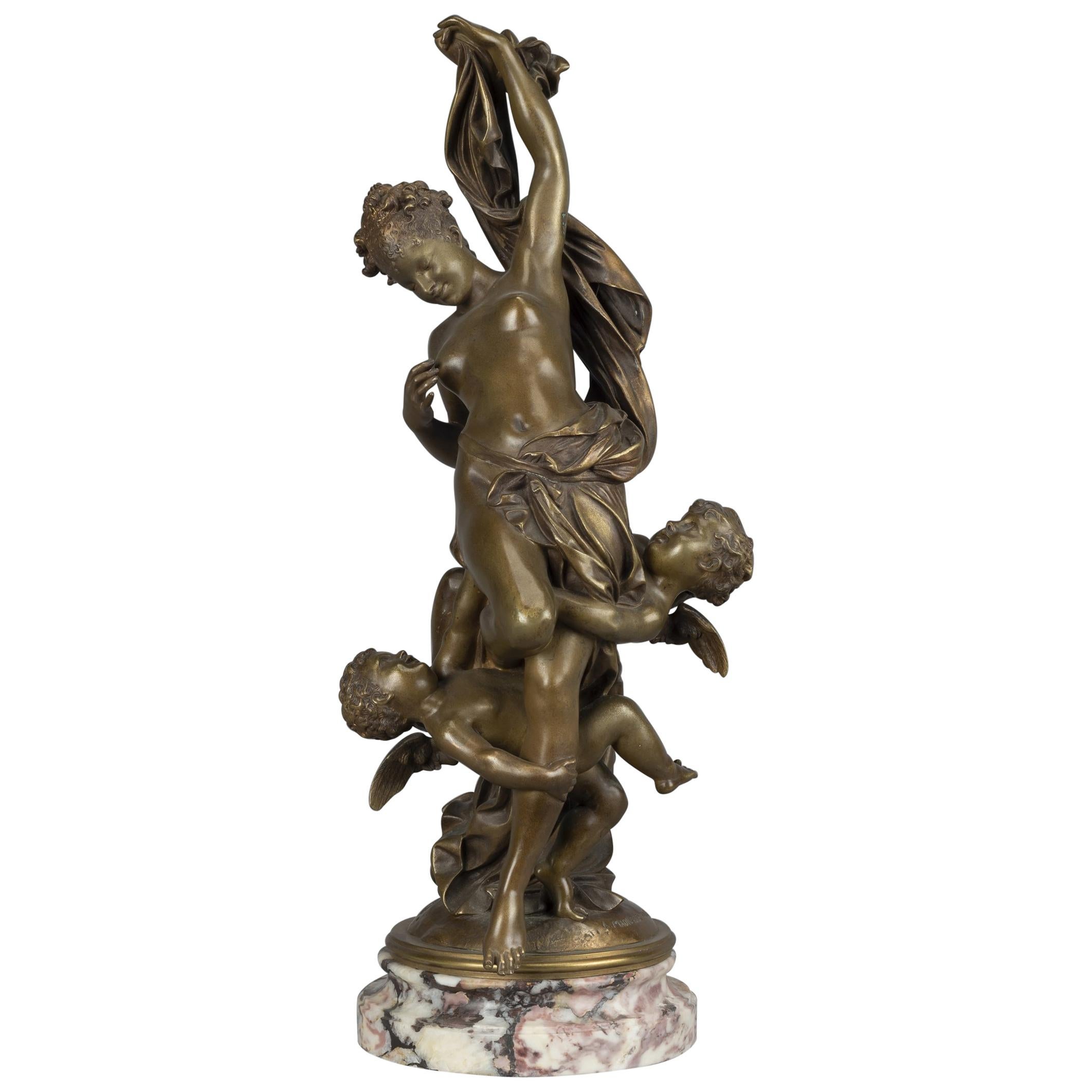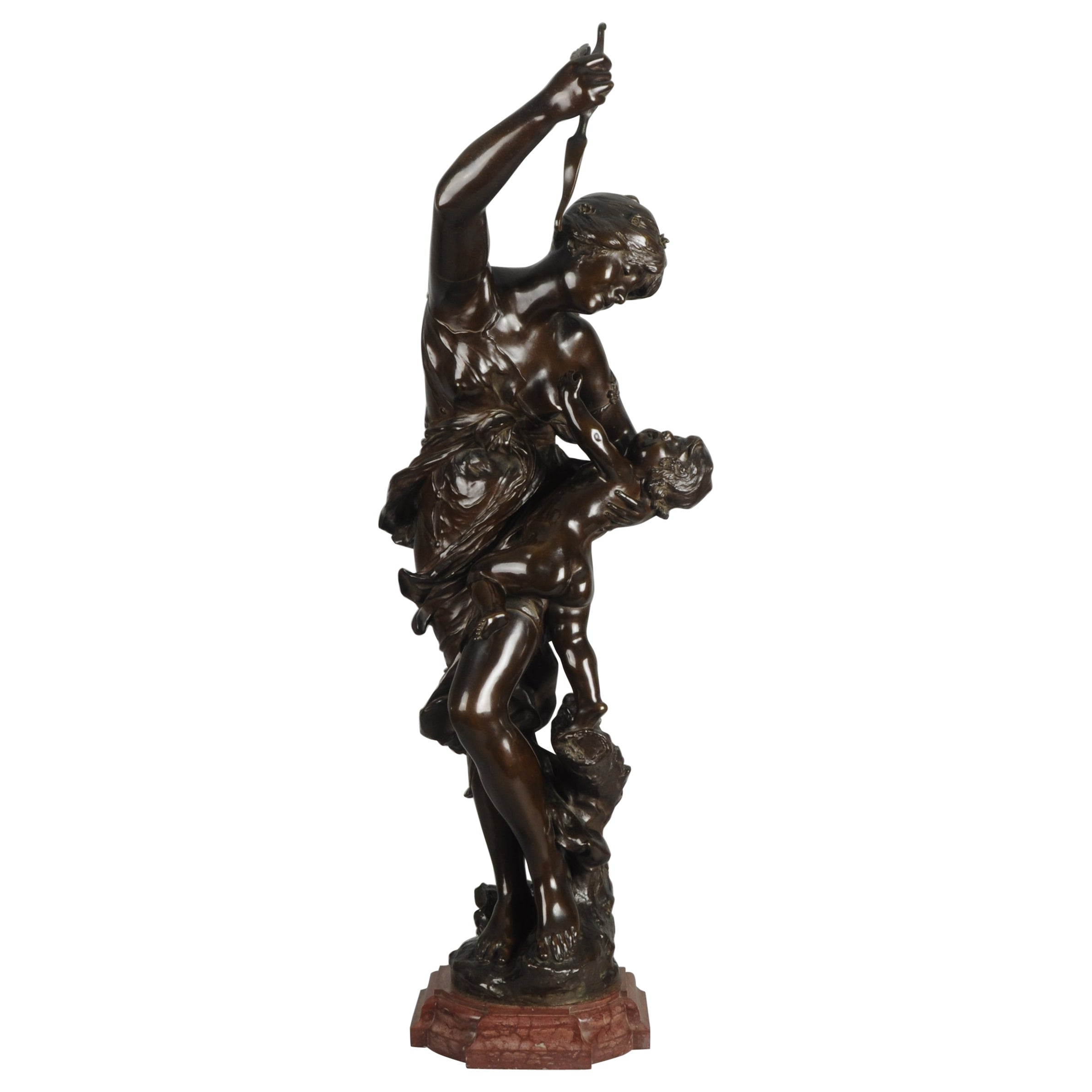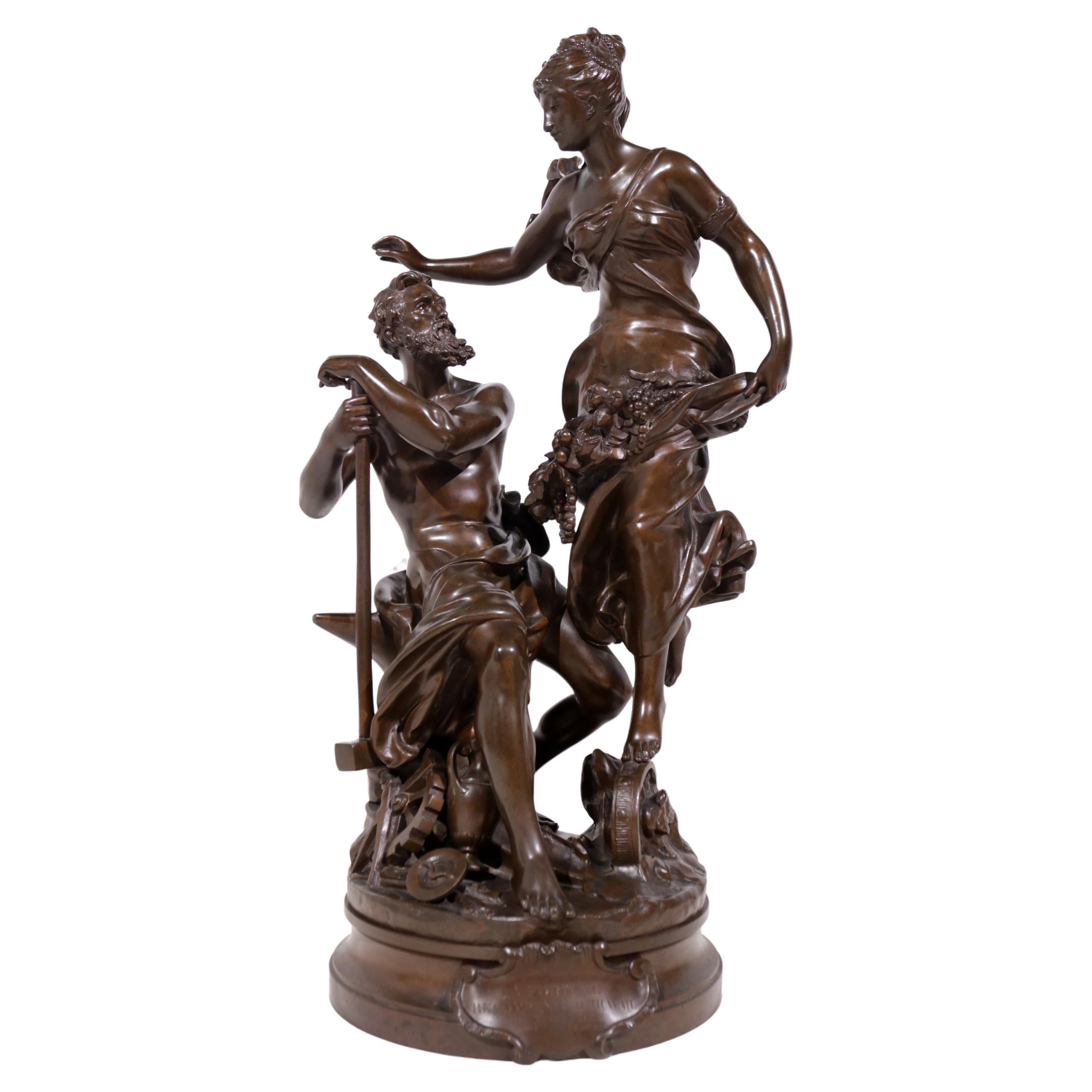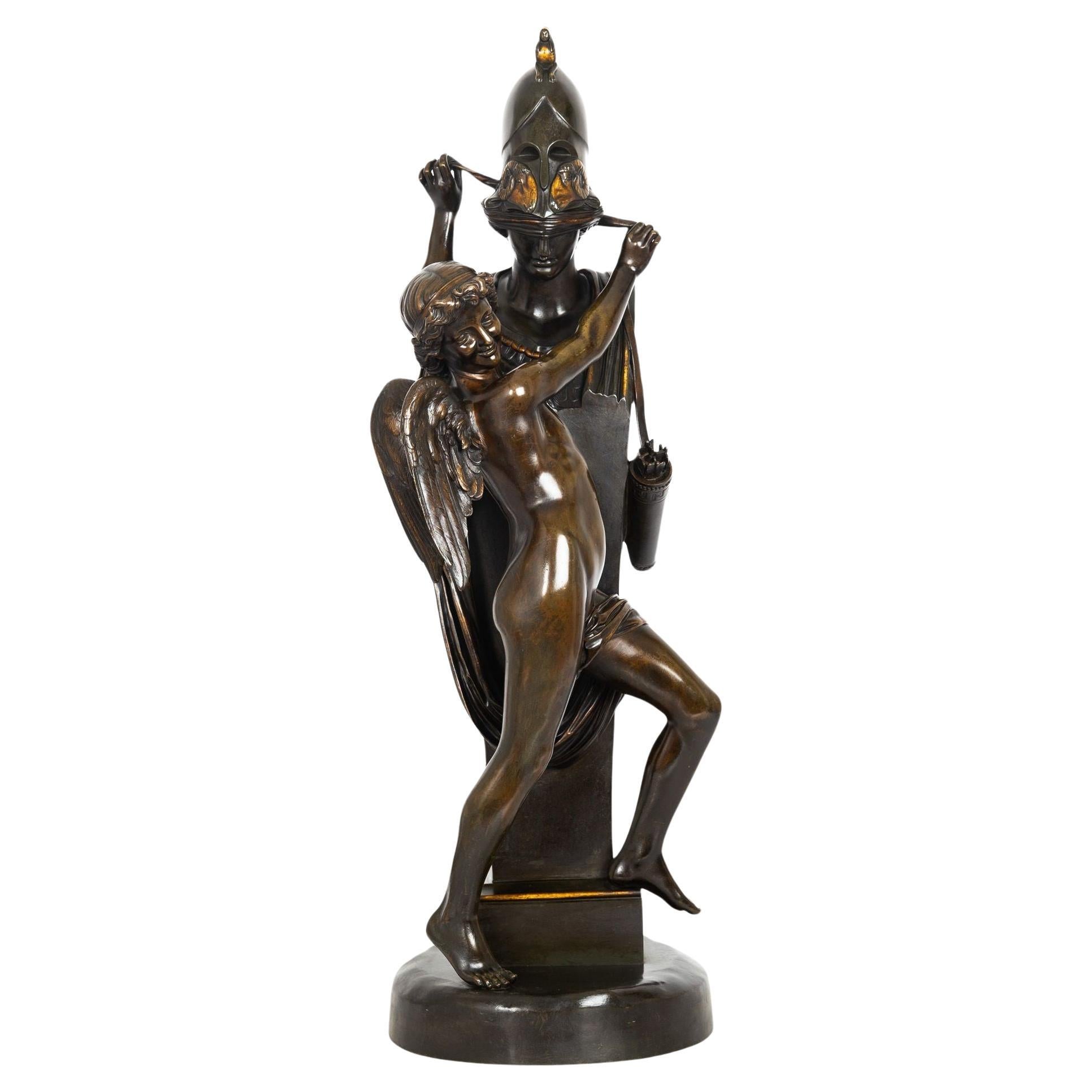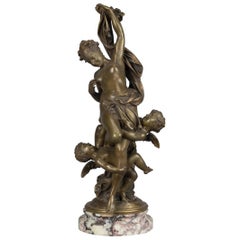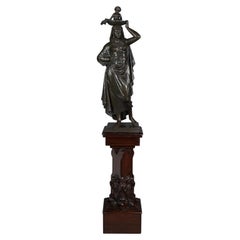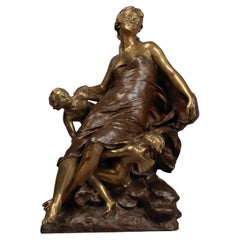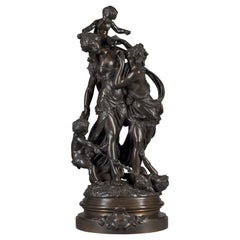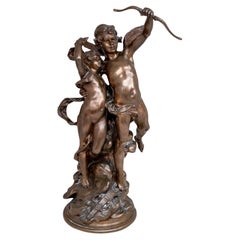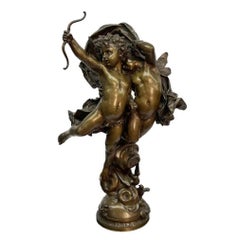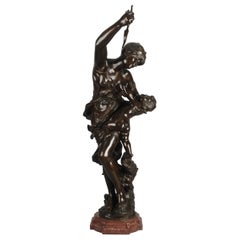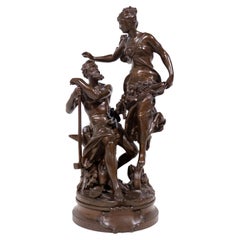Items Similar to 'L'Amour Vainqueur' ('A Love Vanquished') By Adolphe Itasse (French, 1830 - 1893
Want more images or videos?
Request additional images or videos from the seller
1 of 13
'L'Amour Vainqueur' ('A Love Vanquished') By Adolphe Itasse (French, 1830 - 1893
$32,872.83
£24,000
€28,209.26
CA$45,385.38
A$50,316.40
CHF 26,443.23
MX$615,790.20
NOK 330,249.07
SEK 309,971.79
DKK 210,564.59
About the Item
A Fine Patinated Bronze Figural Group of Cupid and Psyche, Entitled 'L'Amour Vainqueur' ('A Love Vanquished') By Adolphe Itasse (French, 1830 - 1893).
On a revolving rouge de France marble base.
Signed and dated ‘A. Itasse / Scvpt / 1887’, inscribed ‘W. BOUGUEREAU. INV’, stamped with a foundry seal, further inscribed: ‘42047 / 6’, and with brass title plaque to the base.
French, Dated 1887.
The inspiration for this fine bronze group was the painting of the same title by the celebrated artist William-Adolphe Bouguereau painted in 1886 and shown at the the Paris Exposition universelle of 1889. In the same way that Bouguereau often drew inspiration from sculptural compositions for his paintings, sculptors were similarly inspired by his work. The subject shows an infant cupid and psyche and prophesises the abjection of psyche as told in the story of Metamorphoses.
- Creator:Adolphe Itasse (Sculptor)
- Dimensions:Height: 31.5 in (80 cm)Width: 16.54 in (42 cm)Depth: 9.45 in (24 cm)
- Materials and Techniques:
- Place of Origin:
- Period:
- Date of Manufacture:Dated 1887
- Condition:Wear consistent with age and use.
- Seller Location:Brighton, GB
- Reference Number:Seller: B776101stDibs: LU1028037671742
About the Seller
5.0
Recognized Seller
These prestigious sellers are industry leaders and represent the highest echelon for item quality and design.
Established in 1964
1stDibs seller since 2014
58 sales on 1stDibs
Typical response time: 6 hours
Associations
The British Antique Dealers' AssociationLAPADA - The Association of Arts & Antiques Dealers
- ShippingRetrieving quote...Shipping from: Brighton, United Kingdom
- Return Policy
Authenticity Guarantee
In the unlikely event there’s an issue with an item’s authenticity, contact us within 1 year for a full refund. DetailsMoney-Back Guarantee
If your item is not as described, is damaged in transit, or does not arrive, contact us within 7 days for a full refund. Details24-Hour Cancellation
You have a 24-hour grace period in which to reconsider your purchase, with no questions asked.Vetted Professional Sellers
Our world-class sellers must adhere to strict standards for service and quality, maintaining the integrity of our listings.Price-Match Guarantee
If you find that a seller listed the same item for a lower price elsewhere, we’ll match it.Trusted Global Delivery
Our best-in-class carrier network provides specialized shipping options worldwide, including custom delivery.More From This Seller
View All'L'innocence Tourmentée Par L'amour' A Figural Group by Luca Madrassi circa 1900
By Luca Madrassi
Located in Brighton, West Sussex
'L'innocence Tourmentée Par L'amour' - A fine patinated bronze figural group by Luca Madrassi.
French, circa 1900.
Inscribed 'L.MADRASSI.PARIS'.
With Gervais foundry cachet...
Category
Antique Late 19th Century French Belle Époque Figurative Sculptures
Materials
Bronze
François Truphème (1820 -1880) - 'Moses and Jochebed'
By Thiebaut Freres, François Truphème
Located in Brighton, West Sussex
'Moses and Jochebed - A Fine Patinated Bronze Figural Group After A Model by 'François Truphème', Cast by 'Thiebaut Frères'.
Signed 'Fois Truphème 1863' and 'fdu par Vor Thiebaut'....
Category
Antique Mid-19th Century French Figurative Sculptures
Materials
Bronze
'Cupid & Psyche' an Important Bronze Figure by François-Raoul Larche
By François-Raoul Larche
Located in Brighton, West Sussex
'Cupid & Psyche' - An important parcel-gilt and patinated bronze figure, by François-Raoul Larche.
Signed to the base 'Raoul Larche 1891'.
This finely cast parcel-gilt bronze figure depicts Cupid and Psyche with Zephyr.
François-Raoul Larche (1860-1912), the son of an ornamental sculptor, was a well-known Art Nouveau sculptor...
Category
Antique 19th Century French Figurative Sculptures
Materials
Bronze
'Bacchantes', a Fine Patinated Bronze Figural Group After Clodion, circa 1870
By Claude Michel Clodion
Located in Brighton, West Sussex
'Bacchantes', a fine patinated bronze figural group after Claude Michael Clodion, French (1738-1814).
French, circa 1870.
Signed 'Clodion' to the base and inscribed 'BACCHANTE...
Category
Antique Late 19th Century French Figurative Sculptures
Materials
Bronze
'La Nature se dévoilant devant la Science' by Louis-Ernest Barrias
By Louis Ernest Barrias
Located in Brighton, West Sussex
'La Nature se dévoilant devant la Science', A Large and Rare Gilt and Silvered Bronze and Marble Figure entitled ('Nature unveiling itself before science') By Louis-Ernest Barrias (...
Category
Antique 19th Century French Belle Époque Figurative Sculptures
Materials
Carrara Marble, Bronze
'Le Puits Qui Parle' an Exhibition Bronze, Paul Eugène Mengin French, circa 1900
By Paul Eugène Mengin 1, Susse Freres
Located in Brighton, West Sussex
'Le Puits Qui Parle' (The Speaking Well) - An Important Exhibition Bronze Group, by Paul Eugène Mengin.
Signed to the cast 'P MENGIN', and inscri...
Category
Early 20th Century French Figurative Sculptures
Materials
Bronze
You May Also Like
Leopold Steiner "Cupid and Psyche" Bronze
By Clément Léopold Steiner 1
Located in Astoria, NY
Clement-Leopold Steiner (French, 1853-1899) "Cupid and Psyche" Patinated Bronze Sculpture, late 19th century, the figures standing on a cloud, signed, and Thiebaut Fres fondours Pari...
Category
Antique Late 19th Century French Belle Époque Figurative Sculptures
Materials
Bronze
Bronze Figural statue "The Winning Love" By Adolphe Itasse after a model
Located in New York, NY
An Exquisite bronze figural pairing of two putti with butterfly wings. One putti holds a bow, while his counterpart cowers behind him. A dynamic piece of fabric hovers over the grouping, showcasing expertly modeled drapery, embellishing the composition of the piece. The figural grouping and pose is base off of a painting by William-Adolphe Bouguereau (1925 - 1905), a french academic painter who created realistic genre paintings of modernized mythological scenes.
Itasse studied under Belloc and Jacquot and exhibited at the Salon from 1864 to 1893. The artist worked on multiple public commissions for the Louvre (Retour de la Chasse), l Opera (Philidor, Puccini, Cambert), the Trocadero Palace (L Astronomie) and Hotel de Ville de Paris.
He specialized in busts, portrait reliefs of contemporary personalities, also sculpting a number of genre and allegorical works, such as The Kiss, The Birth of Love, Astronomy and Science.
Amongst other awards he won a medal at the 1875 Salon and an honorable mention at the Universal Exhibition of 1889.
Artist: Adolphe Itasse...
Category
Late 19th Century Nude Sculptures
Materials
Bronze
19th Century Art Nouveau Bronze Entitled "Venus & Cupid" by Jean Sul-Abadie
By Jean Abadie
Located in London, GB
A very fine bronze study of Venus taking an arrow from Cupid her son, who at times would shoot his arrows without meaning or reason into the hearts of men, igniting their desire. Exhibiting excellent rich brown patina and good detail, signed Sul Abadie and stamped.
Additional information
Height: 93 cm
Condition: excellent condition
Circa: 1885
Materials: bronze & marble
SKU: 4979
ABOUT
Jean Sul-Abadie
Jean Sul-Abadie (Born 1850 ~ Died 15th April 1890) was a French artist, a pupil of Jouffroy and Falguière. Specialising in bronze sculpting in the Art Nouveau style. He made his Salon debut in 1872.
Cupid & Venus
Different tales exist about the origin of Venus and Cupid. Some say that Venus, the goddess of love and beauty, had a love affair with Mars, the god of war. Out of this relationship, Cupid was born. In the following painting you see Venus with Mars, who is being disarmed by Cupid.
Cupid has attributes from both of his parents. Like his mother he is considered to be the god of love, or more precisely, the god of falling in love. He is portrayed as an innocent little child with bow and arrows. He shoots arrows to the heart, and awakening a love that you’re powerless to resist.
In classical mythology, Cupid (Latin Cupido, meaning “desire”) is the god of desire, erotic love, attraction and affection. He is often portrayed as the son of the love goddess Venus and the war god Mars, and is known in Latin also as Amor (“Love”). His Greek counterpart is Eros.
Although Eros is in Classical Greek art as a slender winged youth, during the Hellenistic period, he was increasingly portrayed as a chubby boy. During this time, his iconography acquired the bow and arrow that represent his source of power: a person, or even a deity, who is shot by Cupid’s arrow is filled with uncontrollable desire. In myths, Cupid is a minor character who serves mostly to set the plot in motion. He is a main character only in the tale of Cupid and Psyche, when wounded by his own weapons he experiences the ordeal of love. Although other extended stories are not told about him, his tradition is rich in poetic themes and visual scenarios, such as “Love conquers all” and the retaliatory punishment or torture of Cupid.
In art, Cupid often appears in multiples as the Amores, or amoriniin the later terminology of art history, the equivalent of the Greek erotes. Cupids are a frequent motif of both Roman art and later Western art of the classical tradition. In the 15th century, the iconography of Cupid starts to become indistinguishable from the putto.
Cupid continued to be a popular figure in the Middle Ages, when under Christian influence he often had a dual nature as Heavenly and Earthly love. In the Renaissance, a renewed interest in classical philosophy endowed him with complex allegorical meanings. In contemporary popular culture, Cupid is shown drawing his bow to inspire romantic love, often as an icon of Valentine’s Day.
Venus is the Roman goddess whose functions encompassed love, beauty, sex, fertility, prosperity, victory, and desire. In Roman mythology, she was the mother of the Roman people through her son, Aeneas, who survived the fall of Troy...
Category
Antique Late 19th Century French Art Nouveau Figurative Sculptures
Materials
Breccia Marble, Bronze
Adrien-Etienne Gaudez, French, 1845-1902 Bronze La Fortune Récomponse Le Travail
By Adrien Étienne Gaudez
Located in Boven Leeuwen, NL
Adrien-Etienne Gaudez
La Fortune Récomponse le Travail
signed: A. Gaudez, inscribed title plaque LA FORTUNE RECOMPENCE le TRAVAIL / PAR A. GAUDEZ / HORS C...
Category
Antique 19th Century French Figurative Sculptures
Materials
Bronze
“Love Conquers” French Bronze Sculpture by Felix Sanzel circa 1870
Located in Shippensburg, PA
FELIX SANZEL
French, 1829-1883
"L'Amour vainqueur" [Love Conquers] (1865)
Patinated and burnished bronze signed in cast "Fx Sanzel" a lifetime cast circa 1870
Item # 306PRK21E
An ...
Category
Antique 19th Century French Romantic Figurative Sculptures
Materials
Bronze
Sculpture "Psyche and Love" Signed by Jean Bulio
By Jean Bulio
Located in Paris, FR
Statue in bronze with medal patina "Psyche and Cupid" realized by Jean BULIO. It represents Psyche, recognizable by her butterfly wingst. Her chest is bare and she is holding an arro...
Category
Antique 1850s French Figurative Sculptures
Materials
Bronze
More Ways To Browse
Cupid Psyche
Brass Cupid
Psyche Bronze 19th Century French
Bronze Cupid And Psyche
William Bouguereau
Adolphe Bouguereau
Antique Stand Fan
Bas Relief Marble
Bronze Throne
Vintage Italian Capodimonte
Art Deco Goddess
Bisque France
Brutalist Sculpture Figure
Horse Riding Sculpture
Low Relief Sculpture
Marble Sphinx
Mexican Antique Sculpture
Parian Porcelain
